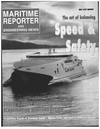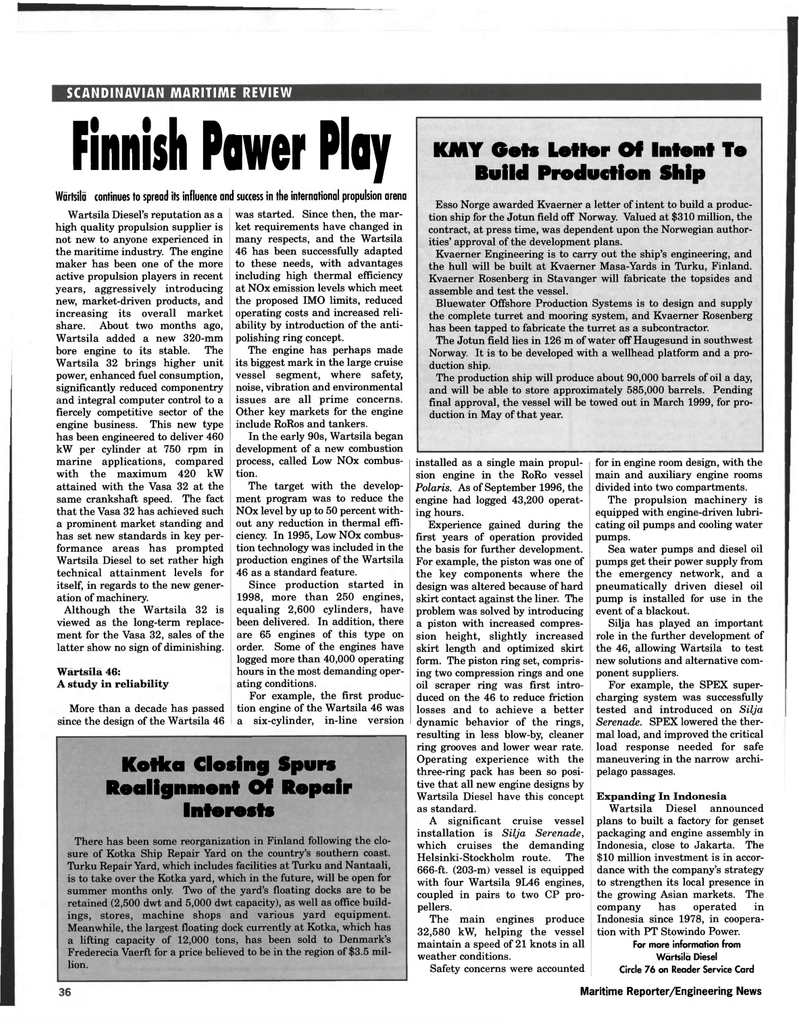
Page 34: of Maritime Reporter Magazine (May 1997)
Read this page in Pdf, Flash or Html5 edition of May 1997 Maritime Reporter Magazine
SCANDINAVIAN MARITIME REVIEW
Finnish Power Ploy
Wartsila continues to spread its influence and success in the international propulsion arena
Wartsila Diesel's reputation as a high quality propulsion supplier is not new to anyone experienced in the maritime industry. The engine maker has been one of the more active propulsion players in recent years, aggressively introducing new, market-driven products, and increasing its overall market share. About two months ago,
Wartsila added a new 320-mm bore engine to its stable. The
Wartsila 32 brings higher unit power, enhanced fuel consumption, significantly reduced componentry and integral computer control to a fiercely competitive sector of the engine business. This new type has been engineered to deliver 460 kW per cylinder at 750 rpm in marine applications, compared with the maximum 420 kW attained with the Vasa 32 at the same crankshaft speed. The fact that the Vasa 32 has achieved such a prominent market standing and has set new standards in key per- formance areas has prompted
Wartsila Diesel to set rather high technical attainment levels for itself, in regards to the new gener- ation of machinery.
Although the Wartsila 32 is viewed as the long-term replace- ment for the Vasa 32, sales of the latter show no sign of diminishing.
Wartsila 46:
A study in reliability
More than a decade has passed since the design of the Wartsila 46 was started. Since then, the mar- ket requirements have changed in many respects, and the Wartsila 46 has been successfully adapted to these needs, with advantages including high thermal efficiency at NOx emission levels which meet the proposed IMO limits, reduced operating costs and increased reli- ability by introduction of the anti- polishing ring concept.
The engine has perhaps made its biggest mark in the large cruise vessel segment, where safety, noise, vibration and environmental issues are all prime concerns.
Other key markets for the engine include RoRos and tankers.
In the early 90s, Wartsila began development of a new combustion process, called Low NOx combus- tion.
The target with the develop- ment program was to reduce the
NOx level by up to 50 percent with- out any reduction in thermal effi- ciency. In 1995, Low NOx combus- tion technology was included in the production engines of the Wartsila 46 as a standard feature.
Since production started in 1998, more than 250 engines, equaling 2,600 cylinders, have been delivered. In addition, there are 65 engines of this type on order. Some of the engines have logged more than 40,000 operating hours in the most demanding oper- ating conditions.
For example, the first produc- tion engine of the Wartsila 46 was a six-cylinder, in-line version
Kotka Closing Spurs
Realignment Of Repair
Interests
There has been some reorganization in Finland following the clo- sure of Kotka Ship Repair Yard on the country's southern coast.
Turku Repair Yard, which includes facilities at Turku and Nantaali, is to take over the Kotka yard, which in the future, will be open for summer months only. Two of the yard's floating docks are to be retained (2,500 dwt and 5,000 dwt capacity), as well as office build- ings, stores, machine shops and various yard equipment.
Meanwhile, the largest floating dock currently at Kotka, which has a lifting capacity of 12,000 tons, has been sold to Denmark's
Frederecia Vaerft for a price believed to be in the region of $3.5 mil- lion.
KMY Gets Letter Of Intent Te
Build Production Ship
Esso Norge awarded Kvaerner a letter of intent to build a produc- tion ship for the Jotun field off Norway. Valued at $310 million, the contract, at press time, was dependent upon the Norwegian author- ities' approval of the development plans.
Kvaerner Engineering is to carry out the ship's engineering, and the hull will be built at Kvaerner Masa-Yards in Turku, Finland.
Kvaerner Rosenberg in Stavanger will fabricate the topsides and assemble and test the vessel.
Bluewater Offshore Production Systems is to design and supply the complete turret and mooring system, and Kvaerner Rosenberg has been tapped to fabricate the turret as a subcontractor.
The Jotun field lies in 126 m of water off Haugesund in southwest
Norway. It is to be developed with a wellhead platform and a pro- duction ship.
The production ship will produce about 90,000 barrels of oil a day, and will be able to store approximately 585,000 barrels. Pending final approval, the vessel will be towed out in March 1999, for pro- duction in May of that year. installed as a single main propul- sion engine in the RoRo vessel
Polaris. As of September 1996, the engine had logged 43,200 operat- ing hours.
Experience gained during the first years of operation provided the basis for further development.
For example, the piston was one of the key components where the design was altered because of hard skirt contact against the liner. The problem was solved by introducing a piston with increased compres- sion height, slightly increased skirt length and optimized skirt form. The piston ring set, compris- ing two compression rings and one oil scraper ring was first intro- duced on the 46 to reduce friction losses and to achieve a better dynamic behavior of the rings, resulting in less blow-by, cleaner ring grooves and lower wear rate.
Operating experience with the three-ring pack has been so posi- tive that all new engine designs by
Wartsila Diesel have this concept as standard.
A significant cruise vessel installation is Silja Serenade, which cruises the demanding
Helsinki-Stockholm route. The 666-ft. (203-m) vessel is equipped with four Wartsila 9L46 engines, coupled in pairs to two CP pro- pellers.
The main engines produce 32,580 kW, helping the vessel maintain a speed of 21 knots in all weather conditions.
Safety concerns were accounted for in engine room design, with the main and auxiliary engine rooms divided into two compartments.
The propulsion machinery is equipped with engine-driven lubri- cating oil pumps and cooling water pumps.
Sea water pumps and diesel oil pumps get their power supply from the emergency network, and a pneumatically driven diesel oil pump is installed for use in the event of a blackout.
Silja has played an important role in the further development of the 46, allowing Wartsila to test new solutions and alternative com- ponent suppliers.
For example, the SPEX super- charging system was successfully tested and introduced on Silja
Serenade. SPEX lowered the ther- mal load, and improved the critical load response needed for safe maneuvering in the narrow archi- pelago passages.
Expanding In Indonesia
Wartsila Diesel announced plans to built a factory for genset packaging and engine assembly in
Indonesia, close to Jakarta. The $10 million investment is in accor- dance with the company's strategy to strengthen its local presence in the growing Asian markets. The company has operated in
Indonesia since 1978, in coopera- tion with PT Stowindo Power.
For more information from
Wartsila Diesel
Circle 76 on Reader Service Card 36 Maritime Reporter/Engineering News

 33
33

 35
35
